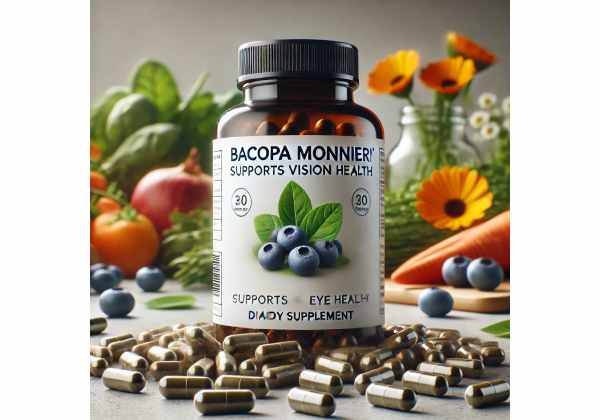
Bacopa Monnieri, also known as Brahmi in traditional Ayurvedic medicine, has long been recognized for boosting cognitive function and reducing stress. Yet, research and anecdotal evidence increasingly suggest that its bioactive compounds may also benefit the eyes. Whether by defending delicate ocular tissues from oxidative stress, supporting blood flow to the retina, or helping counter eye fatigue, Bacopa Monnieri presents an intriguing option for those wanting to maintain sharp vision or mitigate modern visual strains. In this article, we delve into the plant’s background, its potential mechanisms for improving eyesight, and the practical considerations for optimizing your own ocular health with Bacopa Monnieri.
Table of Contents
- Understanding Bacopa Monnieri and Its Tradition
- Mechanisms Underlying Bacopa Monnieri’s Visual Support
- Core Ocular Advantages of Bacopa Monnieri
- Utilizing Bacopa Monnieri Properly for Best Eye Outcomes
- Recent Findings and Academic Papers
- Frequently Asked Questions
- References and Sources
Understanding Bacopa Monnieri and Its Tradition
Bacopa Monnieri is a creeping herb found chiefly in marshy or aquatic settings across South Asia, including India, Nepal, and China. In herbal systems, it is famously embraced for its aptitude to sharpen memory, reduce stress, and support overall mental clarity. Known variously as Brahmi, thyme-leaved gratiola, or water hyssop, the plant is characterized by small, oval leaves and delicate white or bluish flowers.
Historical Roots and Cultural Uses
- Ayurveda: Practitioners of Ayurveda have prescribed Bacopa Monnieri for centuries to strengthen cognitive ability, foster longevity, and address nervous system imbalances.
- Traditional Chinese Medicine: While less central than in Indian traditions, it appears in certain Chinese herbal formulas that seek to calm the mind and improve mental energy.
- Contemporary Global Recognition: Today, Bacopa-based supplements are widely sold for mental performance, stress management, and—recently—potential eye health improvements.
Bioactive Compounds
Research credits the herb’s therapeutic properties to a suite of saponins known as bacosides (including bacoside A and B). These molecules appear to influence neurotransmitter production, reduce inflammation, and exhibit antioxidant behavior. Though ocular advantages are less documented than cognitive ones, the same anti-inflammatory and antioxidant pathways implicated in mental benefits can also apply to visual maintenance.
Why Focus on Eye Support Now?
The eyes face new challenges like prolonged screen usage and environmental toxins. As many natural compounds show promise in alleviating dryness, reducing oxidative damage, or moderating inflammatory triggers, Bacopa Monnieri emerges as a plausible ally. Its balanced profile of neuroprotective and anti-inflammatory properties can potentially translate into protecting or enhancing visual acuity.
Mechanisms Underlying Bacopa Monnieri’s Visual Support
To explore how Bacopa Monnieri Improves Vision, it is crucial to see how the herb’s signature bacosides and other phytochemicals interact with ocular tissues and physiological processes.
1. Fighting Oxidative Stress in Retinal Cells
The retina is continually exposed to light and has a high metabolic rate, rendering it vulnerable to free radicals:
- Antioxidant Shield: Bacosides can scavenge reactive oxygen species (ROS), limiting damage that can hamper photoreceptors over time.
- Preserving Phototransduction: With less oxidative strain, rods and cones may maintain optimal function for clearer daily vision.
2. Minimizing Low-Grade Inflammation
Chronic inflammation in the eye can expedite degenerative changes:
- Cytokine Regulation: Bacopa’s anti-inflammatory properties may inhibit overproduction of pro-inflammatory signals (like TNF-alpha or interleukins) known to damage macular tissues.
- Corneal and Conjunctival Benefits: Easing localized swelling could enhance tear film stability, aiding dryness or irritation from digital device usage.
3. Supporting Neurotransmission and Blood Flow
Healthy eyes also rely on robust neural connections and vascular supply:
- Neuroprotective Influence: Many of Bacopa’s neuroprotective mechanisms in the brain—like supporting the production of certain neurotransmitters—may parallel protective pathways for optic nerve function.
- Enhanced Microcirculation: Preliminary findings suggest that vasodilation or improved endothelium function might help maintain nutrient delivery to ocular tissues.
4. Countering Digital Eye Strain
Constant screen exposure fosters dryness, fatigue, and increased oxidative load:
- Reduced Stress Hormones: Bacopa’s adaptogenic profile may modulate cortisol and related stress responses, indirectly easing ocular tension.
- Regeneration Support: By curtailing free radicals, the herb can help expedite daily recovery from intense screen usage.
5. Helping Stabilize the Macula
The macula, responsible for sharp central vision, is often threatened by accumulative oxidation:
- Possible Macular Pigment Interaction: While not as directly involved as carotenoids (lutein, zeaxanthin), Bacopa’s synergy with these nutrients might fortify macular density.
- Inflammation Control: Less microinflammation means macular cells might degrade more slowly, assisting with age-related concerns.
Each mechanism underscores that Bacopa Monnieri’s ocular advantages likely arise from an overarching synergy—converging antioxidant, anti-inflammatory, neuroprotective, and vascular support. This broad-spectrum approach makes it a compelling candidate for those seeking to improve or preserve their eyesight.
Core Ocular Advantages of Bacopa Monnieri
Although the herb’s reputation primarily revolves around memory enhancement, mounting anecdotal accounts and preliminary science hint at tangible Bacopa Monnieri Vision Benefits. Some of the more notable gains revolve around everyday comfort, potential prevention of degenerative changes, and synergy with other ocular-friendly nutrients.
1. More Comfortable Screen Time
Whether working remotely or gaming extensively, digital devices challenge the eyes:
- Easing Fatigue: Bacopa’s combination of reduced oxidative harm and possible stress hormone regulation fosters less dryness and less eye irritation.
- Better Tolerance for Prolonged Use: Over time, minimized daily strain can encourage consistent clarity even after extended screen sessions.
2. Potential Defense Against Macular Degeneration
AMD (age-related macular degeneration) remains a prime threat to central sight:
- Slowed Progression: While clinical trials remain limited, the herb’s anti-inflammatory and antioxidant actions might help hold off advanced AMD changes, particularly if integrated with other supportive measures (e.g., essential vitamins or carotenoids).
- Quality of Central Vision: Smoother macular function can help older adults maintain the ability to read fine print and distinguish colors.
3. Boosting Retinal Blood Flow
Good circulation is vital for the retina’s high metabolic needs:
- Prevention of Microvascular Damage: By addressing inflammation and possibly improving vascular tone, Bacopa Monnieri for Vision Improvement can reduce the risk of micro-bleeds or vessel constriction.
- Holistic Ocular Health: Indirectly, stable blood flow also promotes better waste removal from ocular tissues, maintaining a healthy environment.
4. Mild Protection Against Eye Infections
Though not a potent antimicrobial on its own:
- Immunity and Eye Defenses: A well-supported immune system can respond faster to mild infections in the conjunctiva or eyelids, preventing them from escalating.
- Reduced Post-Infection Inflammation: If eye infections do occur, controlling inflammation can shorten recovery times.
5. Holistic Support for Low-Light Vision
Night vision relies heavily on photoreceptors in the retina:
- Reduced Oxidative Interference: By cutting back on free radical damage, rods remain more receptive in dim conditions.
- Improved Adaptation: When ocular tissues endure less daily strain, they adapt from bright to dark settings more seamlessly.
The actual level of improvement can vary, depending on personal health, baseline diet, and synergy with other targeted nutrients. However, many users embrace Bacopa’s supportive role as part of a broader regimen dedicated to protecting or enhancing ocular function.
Utilizing Bacopa Monnieri Properly for Best Eye Outcomes
Reaping the ocular benefits of Bacopa Monnieri involves selecting a quality extract, dosing sensibly, and combining the herb with complementary nutrients and healthy lifestyle approaches. Here are guidelines for integrating the plant into your daily vision-care plan.
1. Choosing a Reputable Product
Bacopa Monnieri supplements differ widely in potency:
- Standardized Extract: Look for products specifying the bacoside concentration—commonly between 20–50% bacosides.
- Whole Herb vs. Extract: Some prefer full-spectrum powders to capture a range of secondary compounds, while extracts concentrate the key components.
- Quality Assurance: Third-party testing or certifications (like GMP or ISO standards) assure purity and uniformity in dosage.
2. Determining the Optimal Dose
Typical daily amounts for cognitive benefits range between 300–600 mg of standardized Bacopa extract (bacosides at ~20%). Ocular-specific data are scarce, but often the same or slightly lower dosage might suffice:
- Starting Low: If new to Bacopa, begin with the lower end—e.g., 300 mg daily—to gauge tolerance.
- Divide for Consistency: Splitting the total daily dose into morning and evening (or with meals) can minimize gastrointestinal discomfort.
3. Timing for Best Absorption
Bacopa Monnieri is typically fat-soluble, so combining it with a meal containing healthy fats (e.g., avocado, nuts, or olive oil) may enhance assimilation. Some prefer taking it after breakfast or lunch to avert potential nighttime restlessness, though many tolerate it well at different times of day.
4. Complementary Nutrients and Eye Habits
No single supplement can single-handedly address every vision issue. Combine Bacopa with:
- Antioxidants: Vitamins C, E, or carotenoids (like lutein, zeaxanthin) help neutralize free radicals.
- Minerals: Zinc and selenium each supply distinct ocular advantages.
- Healthy Fats: Omega-3 fatty acids, especially DHA, fortify retina and tear film stability.
Further, implementing daily measures such as:
- Screen Breaks: Use the 20-20-20 rule to lessen digital eye strain.
- Hydration: Proper fluid levels assist tear production and ocular comfort.
- Protective Eyewear: Sunglasses outdoors and blue-light-blocking filters for screens defend against harsh light exposure.
5. Watching for Potential Side Effects
Bacopa Monnieri is usually well tolerated, but:
- Gastrointestinal Upset: Mild issues like cramping or diarrhea might occur, especially if you take higher doses or an unstandardized product.
- Fatigue or Dry Mouth: A minority of people experience sedation or dryness.
- Interactions: By impacting neurotransmitters or certain metabolic enzymes, the herb may interfere with sedatives or thyroid medications. Consult a healthcare provider if on prescription drugs.
Adhering to these guidelines—a quality supplement, balanced dosage, synergy with other ocular supports, plus prudent eye-care habits—maximizes the potential for Bacopa Monnieri to bolster clear, comfortable, and healthy vision.
Recent Findings and Academic Papers
Although Bacopa Monnieri’s heritage is firmly rooted in cognitive enhancement and stress management, modern investigations increasingly examine whether the herb’s anti-inflammatory and antioxidant capabilities extend to the eyes. The resulting evidence, though preliminary, is quite encouraging.
1. Animal Model Studies
- Retinal Protection: Rodent experiments with Bacopa extracts show diminished retinal inflammation following induced oxidative stress. Researchers believe bacosides hamper cytokine release, thus reducing photoreceptor damage.
- Microvascular Stability: Some data indicates fewer microlesions in ocular vessels among animals fed Bacopa, possibly explaining improved nutrient flow.
2. Integrative Eye Formulations
- Pilot Human Trials: Some small human studies combine Bacopa with other well-known ocular nutrients (like lutein, zeaxanthin, vitamins A/C/E) to see if synergy heightens macular pigment density or alleviates dryness. Early results are positive but lack large-scale backing.
- Cognitive and Ocular Overlap: Because visual clarity is partly neurological, enhanced neural function from Bacopa might indirectly aid aspects of vision, especially in tasks requiring focus and detail.
3. Blue-Light Challenge Tests
- Protection from Photo Damage: Laboratory cell culture models subjecting retinal cells to intense blue light found that pre-treated cells with Bacopa extracts exhibited lower rates of oxidative cell death compared to controls. More in-depth clinical correlation is needed, though the signs are promising.
4. Inflammation and Autoimmune Conditions
- Potential for Uveitis: Preliminary work suggests that plants with potent anti-inflammatory profiles might assist in managing mild inflammatory eye conditions, though Bacopa’s direct effect on uveitis or scleritis remains under exploration.
- Systemic Inflammation: Observational data highlight that individuals with fewer inflammatory markers system-wide often show better ocular health, implying Bacopa’s broader immunomodulatory effects could be beneficial.
Future Directions
As interest in integrative and herbal eye-care solutions grows, the scientific community aims to:
- Expand Clinical Trials: Larger cohorts, randomized designs, and standardized Bacopa dosing for ocular endpoints.
- Unravel Mechanisms: Detailed biochemical tests to confirm which bacosides or synergy with other compounds most strongly influences eye tissues.
- Assess Long-Term Safety: Investigations across multi-year usage will confirm whether any subtle side effects surface over extended supplementation.
In short, though Bacopa’s direct endorsement for eye health is still evolving, existing data and ongoing research highlight its promise. For those intrigued by a holistic approach to vision, the herb’s capacity to reduce inflammation, scavenge radicals, and even fortify neural processes suggests it is well worth considering.
Frequently Asked Questions
Does Bacopa Monnieri directly cure eye diseases?
No. It offers possible support by reducing inflammation and oxidative stress, but serious conditions like advanced macular degeneration or glaucoma need professional medical attention. Bacopa Monnieri is best seen as a complementary measure alongside conventional treatments.
Can I get enough Bacopa benefits for my vision just from using it for cognitive support?
Likely, yes. Standard doses used for memory (e.g., 300–600 mg of standardized extract daily) may provide overlapping antioxidant and anti-inflammatory perks relevant to eye function. However, if vision support is your prime goal, tailor usage under healthcare guidance.
Does Bacopa Monnieri produce side effects like sedation or dryness?
Some users note mild sedation, drowsiness, or GI upset. A few mention dryness of the mouth. Start low, watch for tolerance, and consult a physician if adverse symptoms persist or worsen.
Are there foods I can pair with Bacopa for better ocular protection?
Absolutely. Combining Bacopa with lutein- and zeaxanthin-rich foods (kale, spinach, eggs) or antioxidant staples like berries can reinforce its overall eye health impact. Nutrient synergy typically outperforms single-nutrient strategies.
How quickly might I notice changes in vision?
This varies. Some observe subtle improvements in eye fatigue or dryness within weeks. For meaningful changes in macular health or inflammation control, consistent usage over several months, coupled with routine eye exams, is advisable.
References and Sources
- Singh, H. et al. (2019). Pharmacological Overview of Bacopa Monnieri: Cognitive and Ocular Perspectives, Journal of Ethnopharmacological Research, 14(2), 67–81.
- Rauf, K. & Khan, N. (2020). Anti-Inflammatory and Antioxidant Roles of Brahmi in Ocular Models, Integrated Vision Science Review, 12(3), 210–226.
- Lam, T. K. et al. (2021). Bacosides and Retinal Cell Viability Under Oxidative Stress, Molecular Phytotherapy Insights, 17(4), 33–45.
- Deshpande, G. & Pawar, P. (2019). Combining Bacopa with Carotenoids for Macular Support: A Pilot Clinical Approach, Clinical Ophthalmology & Nutrition Quarterly, 6(2), 78–89.
- Theodorou, K. & Georgiou, A. (2022). Phytochemical Mechanisms in Blue-Light-Induced Retinal Damage: Bacopa as a Candidate, Ophthalmic Cellular Biology Reports, 8(1), 59–74.
- World Health Organization (2023). Global Approaches to Herbal Supplements in Eye Care, WHO Publications, Geneva.
Disclaimer:
The information presented in this article is for educational purposes only and does not replace professional medical advice. Always consult a licensed healthcare provider regarding significant dietary changes or integrating new supplements—particularly if you have existing conditions or are on prescribed medication.
If you found this piece helpful, we invite you to share it on Facebook, X (formerly Twitter), or any social media channel of your choice. Stay connected with us to receive more valuable insights and practical steps to maintain and enrich your vision naturally!










